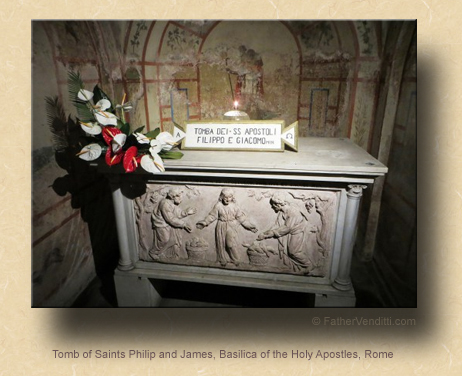Come and See.
The Feast of Saints Philip and James, Apostles.
Lessons from the proper, according to the ordinary form of the Roman Rite:
• I Corinthians 15: 1-8.
• Psalm 19: 2-5.
• John 14: 6-14.
The Third Wednesday after Easter; and, the Commemoration of Saints Alexander, Eventius & Theodolus, Martyrs, and Saint Juvenal, Bishop & Confessor.
Lessons from the dominica,* according to the extraordinary form of the Roman Rite:
• I Peter 2: 11-19
• [The Gradual is omitted.]
• John 16: 16-22.
|
If a Mass for the commemoration is taken, lessons from the Common of Martyrs "Sancti tui…" for Many Martyrs:
• I Peter 1: 3-7.
• [The Gradual is omitted.]
• John 15: 5-11.
|
Wednesday of the Ointment-Bearers; the Feast of the Holy Martyr Timothy & His Wife Maura; and, the Feast of our Venerable Father Theodosius of the Pecherskaya Lavra.
Lessons from the pentecostarion, according to the Ruthenian recension of the Byzantine Rite:
• Acts 8: 18-25.
• John 6: 35-39.
FatherVenditti.com
|
 7:54 AM 5/3/2017 — Among the Galileans who were fortunate enough to be chosen by our Lord to form part of his intimate circle were Philip, the son of Alphaeus, and James, whom we call James the Less because he was younger than the other Apostle James. 7:54 AM 5/3/2017 — Among the Galileans who were fortunate enough to be chosen by our Lord to form part of his intimate circle were Philip, the son of Alphaeus, and James, whom we call James the Less because he was younger than the other Apostle James.
James the Less was born in Cana, very near Nazareth, and was a relative of Jesus. The Gospel doesn’t record for us the exact moment our Lord met and called him, but we do know that he went on to become Bishop of Jerusalem after Peter had gone to Rome, and wrote the Epistle which Martin Luther rejected because it contradicted his teaching that faith alone justifies without reference to good actions and a holy life. We don’t know the exact circumstances of his death, but it is widely believed that he was beaten or stoned to death for the faith.
Philip was a native of Bethsaida, a little town on the shores of Lake Gennesaret, as were also Peter and his brother Andrew, who were probably close friends of Philip. He was martyred by crucifixion. Philip first met our Lord on the banks of the Jordan as our Lord was making His way to Galilee with some of his first disciples. Jesus said, “Follow me” (John 1: 43). That was how Jesus invited people to join his little company: just two small words. Philip did follow, and right away he began introducing his own friends to the One who had become the center of his life. “And Philip found Nathanael, and told him, ‘We have discovered who it was Moses wrote of in his law, and the prophets too; it is Jesus the son of Joseph, from Nazareth.’ When Nathanael asked him, ‘Can anything that is good come from Nazareth?’…” Philip gave Nathanael the best of all possible replies: “Come and see” (John 1: 45-46).
Sometimes that’s all it takes. When people in your own parish ask you what this place is like and why you come here, instead of trying to explain it, the best answer is to simply say, “Come and see.” When friends, relatives, coworkers, even just casual acquaintances ask why we are Catholic, or why we go to church, sometimes we make the mistake of trying to say too much, and we end up blocking their view of our Lord with our own words, when what we should do is clear the way for them to discover our Lord themselves. We could do worse than to take Philip’s example. When Nathanael asked him whether anything good could come from Nazareth, Philip could have tried to quote the prophets, repeat some of the things already said by our Lord which he found particularly meaningful, or could have told him about the miraculous catch of fish, but he didn’t. He did something much better: he simply said, “Come and see.”

* In the extraordinary form, on ferias outside privileged seasons, the lessons are taken from the previous Sunday.
|

